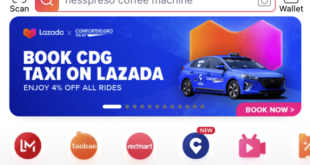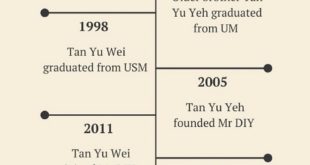Three years ago, Dirk-Jan ter Horst wanted to rent a car to drive up to Malaysia for a few days during the Chinese New Year holidays.
“I tried my luck with a traditional car rental company (and) it was very inconvenient to find a car to rent for those specific days as the rental company only opens during working hours and are closed on public holidays.”
“This meant that I had to pick up the car a day earlier and return it a day later in the morning and I had to pay for (these extra hours),” lamented the 39-year-old Dutch national.
He added that he had to bear additional costs for driving to Malaysia, as well as pay for add-ons like a GPS navigation system and a child seat.
The troublesome booking process and hefty costs made him think about how he can revolutionise the car rental experience in Singapore.
Inspired by his positive experience with a peer-to-peer (P2P) car-sharing platform in Europe, he co-founded Drive lah with his partner Gaurav Singhal in 2018.
Over 11 Million Of Unused Car Hours A Day In S’pore
According to Drive lah’s research, the total number of unused car hours per day in Singapore is 11,520,548.
While this number is indeed staggering, Dirk-Jan finds that this number is nothing extraordinary as it is commonplace in other countries too.
We use cars inefficiently. Those that own cars, they probably use it only one hour a day. Every 24 hours, you’re only driving for an hour and (the remaining) 23 hours, it’s parked somewhere.
(Moreover), cars in Singapore are very expensive. For a very standard car, you spend $ 1,500 per month — that’s $ 18,000 a year. So if you’re only using it five per cent of the time, 95 per cent of the time it is parked somewhere. It is an incredible waste.
– Dirk-Jan ter Horst, co-founder of Drive lah
Therefore, instead of letting the cars go idle, Drive lah is letting car owners monetise it by renting their cars out.
With its P2P car-sharing model, it can help to create a better environment by using assets more efficiently, and ultimately drive down the number of unused car hours.
When they first started out, Dirk-Jan said they approached the Land Transport Authority (LTA) and the Minister of Transport at the time to pitch their service and explain their challenges.
“They were convinced by our model (and) there was no doubt on the concept, because it is already existing in the United States and Europe for many years, just not in Asia.”
“It’s great that it works somewhere else, but will it work in Singapore as well? That is what we needed to prove,” he added.

So in 2019, LTA granted Drive lah to run a year-long trial to allow private car owners to rent out their vehicles and they have since proven that P2P car-sharing improves mobility in the city and reduces congestion.
Drive lah has also been awarded by the Ministry of Trade and Industry (MTI) for its partnership with LTA.
“Airbnb For Cars”

Dirk-Jan claims that Drive lah has the “largest fleet” among car-sharing companies in Singapore with over 1,000 cars.
Interestingly, they don’t own any of these cars. This is why they have been dubbed the “Airbnb for cars” — they adopt an asset-light model and rely on car owners to share their assets.
Much like Airbnb, Drive lah’s business model is predicated on connecting people who have something to offer with others who need what they have.
“You can get as many cars as you want, as many different models that you want and from as many different locations,” said Dirk-Jan.
“You can have one on every HDB, every multi-storey carpark. We’re not bound by anything in that sense, and that’s how we grow so fast.”
Drive lah serves as a transport alternative for those who wants to forego the cost and hassle of car ownership, as well as the inconvenient and expensive traditional car rental services.
While most may think that taking a cab or ride-hailing car is a more viable option, taking multiple trips can be quite costly as opposed to renting a car.
Cabs and ride-hailing adopt a point A to B model. If you want to go from your house to somewhere, this is a great option. But if you want to take longer trips — go from A to B to C and back to A, for example — that will take four trips and can be quite costly.
Drive lah, on the other hand, offers rental by the hour or day, so you can drive anywhere you want within the booking period at a fixed rate.
– Dirk-Jan ter Horst, co-founder of Drive lah
Moreover, since cars are so expensive, it helps car owners to reduce their cost of ownership by ‘sharing’ their cars with others.
“At the start, it took a lot of hard work to convince people to share their cars with fellow Singaporeans. Fortunately, we have been able to convince enough people to be able to offer cars for nearby users,” said Dirk-Jan.
“As more and more people started using it and shared their experiences with others, we have seen more people signing up. Convincing people becomes easier.”
How To Rent With Drive Lah
With Drive lah, users can rent cars by the hour, day, week or month without any financial commitment. There is no registration or monthly fees involved to start renting.
“Car owners set their daily or hour price (and) for every trip, we add a fee to cover for insurance and the development of the platform,” said Dirk-Jan, adding that users are comprehensively insured by Tokio Marine and NTUC.

He also claims that the total costs on Drive lah are “30 to 40 per cent cheaper than anywhere else.”
To start renting a car from Drive lah, you would need to sign up first. This means that you need to create a profile, as well as upload a photo of your driving license and NRIC.
The Drive lah team will then verify your eligibility, which is based on a number of criteria. For instance, users who are Singapore citizens and PRs should be at least 22 years old, and have a minimum two years of driving experience.
Once the verification is done, the user can search for cars by entering location and dates, and book the car they want to drive on Drive lah’s website or mobile app.
Most of the times, cars are available on instant booking and once you’ve made payment, the booking is confirmed.
Upon collection, you have to take a photo of the car first. If any dispute arises between the owner and user after the trip (eg. car owner says that there is a dent or scratch on the car), the photos can serve as “proof” to verify the condition of the car.
While disputes don’t happen often, prevention is better than the cure, stressed Dirk-Jan.
After both parties (owner and user) have taken photos of the car and confirmed pick-up, the user can then proceed to start driving.
Dropping off the car follows the same process — you take photos of the car first before confirming drop-off. The payment will then be instantly released to the car owner, unless there is a dispute that needs to be resolved.
As someone who has personally tried out Drive lah, I find that the booking process was unfortunately not as quick and intuitive as booking a Grab ride.
Firstly, I couldn’t find a car that is near to my location on a Friday (I stay at Yew Tee and the nearest car was at Jelapang, which is about 4km away), but found an available car for booking on Saturday.
Also, my payment didn’t manage to go through due to “insufficient funds”. Since the payment failed, I had to redo the booking process all over again.
I had initially used my GrabPay card (with sufficient funds) for payment, but realised that there is a $ 250 “pre-authorisation” fee. Therefore, it is advisable to pay with a credit or debit card, instead of using an e-wallet.
Do take note that this fee is only applicable for new guests with less than three trips, or for existing users who have been involved in a dispute or accident.

In total, I paid $ 85.30 for a 22-hour rental (from Sunday, 9am to Monday, 7am) for a Honda Jazz car. This equates to about $ 3.90 per hour, excluding petrol and parking fees.
While I faced some hiccups during the booking process, collection and drop-off of the car was a breeze.
That said, it would be better if the Drive lah app allows users to directly call the car owner (much like how you can call your GrabFood rider without needing his contact details), instead of waiting on in-app replies.
The collection process can also be made even more convenient if you opt for cars that are Drive lah Go-enabled.
Such cars are installed with a device that allows the user to open the car keyless, as well as tracks where the car is going.
When you come close to the car at the time of booking, the device will recognise your phone because the virtual key is sent to your app.
When you launch the app, the car will recognise the code in the app. You can then unlock the car and start it without using the car key. Basically, you don’t need a physical key because you can do it with just your phone.
– Dirk-Jan ter Horst, co-founder of Drive lah
He explained further that when you return the car and after the trip is done, that connection will be broken, which means that you can no longer access the car.
In all, with Drive lah Go, you can simply unlock cars with just your mobile phone, so there is no longer a need to personally meet the owner to collect or return the car key.
COVID-19 Causes Change In Mobility Landscape
Both Dirk-Jan and Gaurav quit their jobs and did not draw a salary for the first couple of months to grow the business.
Even now, Dirk-Jan said that they are still “drawing a very small salary” because they chose to reinvest their earnings back into the business to spend on marketing, technology and products.
Drive lah has yet to break even today, but it managed to raise a seed funding of over US$ 1 million last year to build its product and app further, as well as spend on hiring efforts to build the team.
Since the funding round, Drive lah’s revenue has grown 10 times, said Dirk-Jan.

While COVID-19 has badly affected other businesses, he observed that it has boosted demand for car-sharing instead.
Generally, mobility (levels) dropped because people stayed at home (more) than going out. For (ride-hailing services like) Grab and Gojek, as well as taxis, (ridership) dropped massively at 80 per cent.
The same goes for public transport like trains and buses — (ridership) also dropped significantly. However, (ridership for) personal mobility like bicycles and cars went up.
– Dirk-Jan ter Horst, co-founder of Drive lah
He added that because of the contraction in demand for Grab and Gojek, many people who drive for them stopped renting cars from rental companies.
What happened then is that these rental companies that have their cars returned needed to utilise their cars one way or another, so they lowered their rental fees.
In other words, it led to pressure on prices in the car rental market, though it has since bounced back to pre-COVID levels.
Drive Lah Acquires Smove’s Assets
The COVID-19 pandemic also unfortunately forced homegrown car-sharing startup Smove to cease operations.
Following its exit, Smove users have since migrated over to Drive lah.
I know Smove’s CEO and I knew they were having a tough time because of COVID-19.
We learnt that it was no longer viable for them to continue to do business, and the question is this: What can we do with the great company that they built over the years, and what happens to the customers that they serve?
– Dirk-Jan ter Horst, co-founder of Drive lah
Drive lah came to an agreement with them to absorb Smove’s assets and user base to continue to serve Smove’s former customers.
However, since Drive lah does not own any cars, it did not take over Smove’s fleet of cars, which they have since returned to their suppliers.
Today, Drive lah has over 160,000 users. Beyond Singapore, Drive lah recently expanded to Sydney and Melbourne in December last year.
They also have plans to “serve 100 cities in the next five years” with an aim to be the biggest in Asia Pacific.
“Our mission is to provide all customers a seamless and consistent experience, and therefore we continuously improve our product as quickly as we can,” said Dirk-Jan.
“With a great product, we want to convince as many people as possible that easy access to a variety of cars with Drive lah is the better alternative (as opposed to) car ownership.”
Disclaimer: Drive lah has kindly offered Vulcan Post a free trial to try out its car-sharing service. All personal opinions reflected in this article are unbiased and belongs solely to the writer.
Featured Image Credit: Drive lah



